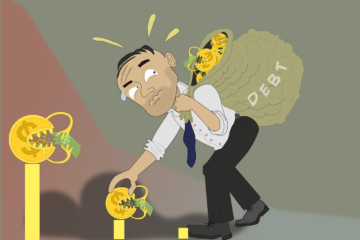Financial professionals disagree on a whole host of issues. However, one of the few financial topics that we agree with nearly unanimously is the importance of an emergency fund. And one of the biggest questions that I have had is “What emergency fund size do I need?” So let’s tackle it.
The Importance of an Emergency Fund
This one is really not up for debate. You WILL have emergencies in your life. You will have a car that breaks down, an unexpected hospital bill, an emergency flight home to see a dying relative, etc.
It will happen.
But in order to be a financially responsible adult, you need to have the money already set aside to pay for such an event.
And you need to have actually SAVED that money.
An emergency fund should not be a credit card, a retirement account, a HELOC, a relative, or any other such product.
An emergency fund should be liquid (meaning that you can access it quickly) and NOT a debt product of any kind.
When you have an emergency, you don’t want to unexpectedly turn that financial problem into an even bigger one.
So where do you save an emergency fund? A savings account at your bank or credit union, a money market account, or cash. Any one of those places are liquid and non-debt products.
A 3-Month to 6-Month Emergency Fund
Although financial professionals don’t really disagree as to the importance of an emergency fund, they do sometimes disagree with the amount that should be in the emergency fund.
But here is my guidance.
As a general rule you should have somewhere between 3 months of your expenses and 6 months of your expenses saved in an emergency fund.
This will vary based on your specific situation (I’ll get to that in a minute). But this is a general guidance.
And to be clear, it is 3-6 months of your EXPENSES, not income.
So if you add up all of your bills and they are $4,000/month, you need a minimum of $12,000 set aside for emergencies.
If you are pretty risk averse and want to put even more money away than 6 months then that is good also. It will just take some time.
A lot of times I am asked when someone should have an emergency fund size closer to the 3-month amount and when someone should have an emergency fund size closer to the 6 month mark. Let me explain.
When to Have a 3-Month Emergency Fund
Like I said before, the size of your emergency fund size will depend on your specific situation. But here are some general rules to follow if you want to error on the smaller side of your emergency fund.
- If you are a dual-income household and both of your jobs are relatively stable and secure (such as government workers, teachers, nurses, military, etc.).
- You are in the process of saving for a bigger emergency fund but just aren’t there yet.
- If you were to lose your job and can easily replace it without too much of a problem.
- If you have kept your debt load to a minimum.
As you can see, if your financial situation is more stable, then you can probably get away with having a smaller emergency fund. But the more unstable your financial life is, the more you need to have in savings.
When to Have a 6-Month Emergency Fund
Since having a 3-month savings is meant for people who have more stable financial situations, the more unstable or risky that your financial situation is, the more you need to have put aside for a rainy day. Here are some examples of financial situations that would likely need to have a larger amount put aside for an emergency.
- If you are a single-income household (even if you do not have a partner and/or children).
- If you are in sales.
- If you depend on commission and/or bonuses as a large part of your pay.
- If your job is less stable in the event of a downturn in the economy (i.e. tech or manufacturing).
- If you feel better and more stable having a larger amount of money put aside for a rainy day.
Final Thoughts
So here’s the deal. Having money put aside for when your life goes bad is a non-negotiable. You simply have to do it.
But I understand that you can do the math of your situation and think that it is impossible to save that much money.
For example, if your expenses are $3,000/month, it might seem pretty daunting to save up $9,000 at a minimum. I get that. I have been there also.
For full disclosure, when I started saving money for a rainy day, I started with $250/month. After a year I had a little more than $3,000. And each month it grows another $250. It took me about 3 years to get to the 3-month stage of my emergency fund.
If you find yourself in the same place, that is okay!
At the same time, if you find some extra money coming your way like a tax refund or a bonus, save it! I know it’s not sexy, but it will help you SOOOOO much in the long run.
I am here for you!
You can do this!
Until next time!



0 Comments